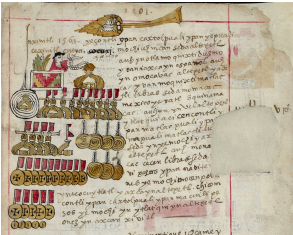seda (CST47)
This painting of the simplex glyph for the term seda (a loan from Spanish that entered Nahuatl, meaning “silk”) shows a large hank of brown silk threads in the shape of a modern clothes hanger, and this is hanging from a horizontal bar. The contextualizing image shows that most hanks weighed 20 pounds each. The hank is twisted and tied in three places and attached to a hook. Kevin Terriciano (2021, 82) reports that the hanks had to be able to be opened and inspected by a decree from the viceroy. The silk economy was introduced into sixteenth-century Oaxaca by the Spanish colonizers. Small amounts of silk are still raised in out-of-the-way pockets of the Mixteca.
Stephanie Wood
The contextualizing image shows the massive amount of silk that the town produced in 1561, which sold at a rate of 4.5 pesos per pound. After Spanish property owners and the church took portions of the haul (adding up to 10 pounds), the remaining 690 pounds brought the town over 3,000 pesos gross income. This was a huge moneymaker for a few decades until silk from China came flooding into New Spain by way of the Manila galleons. A glyph showing another shape for a silk hank (below) comes from Huexotzinco in 1560. For more on the Codex Sierra, see Kevin Terraciano’s study (2021), especially pp. 77–83 on the silk industry.
Stephanie Wood
1550–1564
Jeff Haskett-Wood
ventas, comercio, economía, mercancías, hilos, textiles

seda
Stephanie Wood
Códice Sierra-Texupan, plate 47, page dated 1561. Origin: Santa Catalina Texupan, Mixteca Alta, State of Oaxaca. Kevin Terraciano has published an outstanding study of this manuscript (Codex Sierra, 2021), and in his book he refers to alphabetic and “pictorial” writing, not hieroglyphic writing. We are still counting some of the imagery from this source as hieroglyphic writing, but we are also including examples of “iconography” where the images verge on European style illustrations or scenes showing activities. We have this iconography category so that such images can be fruitfully compared with hieroglyphs. Hieroglyphic writing was evolving as a result of the influence of European illustrations, and even alphabetic writing impacted it.
https://bidilaf.buap.mx/objeto.xql?id=48281&busqueda=Texupan&action=search
The Biblioteca Digital Lafragua of the Biblioteca Histórica José María Lafragua in Puebla, Mexico, publishes this Códice Sierra-Texupan, 1550–1564 (62pp., 30.7 x 21.8 cm.), referring to it as being in the “Public Domain.” This image is published here under a Creative Commons license, asking that you cite the Biblioteca Digital Lafragua and this Visual Lexicon of Aztec Hieroglyphs.




